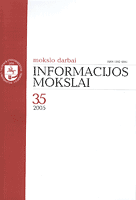Televizijos reklamos elementai ir auditorija: santykio bruožai
Elements of TV Advertisements and the Audience: Features of Relationship
Author(s): Daiva Sirtautienė, Vytautas SirtautasSubject(s): Economy
Published by: Vilniaus Universiteto Leidykla
Summary/Abstract: The expansion of percentage frequencies of the total sample examination results revealed the diversity of the evaluation of advertisements. Given the highest ratings of the concrete answers to the questionnaire, it turned out that the respondents mainly tended to switch over to a different channel during the advertisements; the favourites among the watched advertisements happened to be comical plots with the action taking place in exotic environments, when they were related to entertainment or leisure activities and when the actors were children; the advertised offer sounded more convincing when coming from common people, with easily memorised music or impressive views as the background. The most frequent statement on purchasing was a doubt whether it was worth buying advertised goods. By means of the factor analysis it was established that the gender factor is primary, and the respondent opinions in the questionnaire expanded most clearly with respect to the gender axis. Given that and the χ2 criterion, one could state that women were more tolerant of advertisements than men; women were more socially oriented; they were pragmatic (with their preference of common people and experts), in advertisements they preferred everydaylife plots related to their own functions and featuring children, household, or food; they liked meaningful leisure and humour, as well as a matter-offact approach; women also tended to purchase more. The answers of men reflected their different nature: men appreciated virtual space, fictional plots, aliens, animated things, as well as objects related to their functions and hobbies (professional activities, technologies, eroticism, fights, or sports). Men tended to purchase less. Given the differences between males and females in the evaluation of advertisement elements, one can conclude that adverts targeting either men or women should feature different complexes of elements oriented towards different nature and functions of the two genders. Different age groups offered fewer differences in their advertisement evaluation than different gender groups. The general view of the TV advertisements in age groups was rather homogeneous. The analysis of the correlated phenomena proved that age and purchasing were not directly related. The factor analysis proved that age differences only corresponded to the third factor, therefore the age as a demographic characteristic was less significant than the gender. The results of the correlative and factor analysis of the total sample revealed the fact of the polarity of the audience. It was established that the audience split into two groups of opposite directions characterised by different evaluation of advertisements: one group preferred the “earthly” things (i.e., whatever was close, safe, domestic, and home- and home environment- related), and represented the horizontal direction, while the other group chose
Journal: Informacijos mokslai
- Issue Year: 2006
- Issue No: 36
- Page Range: 95-108
- Page Count: 14
- Language: Lithuanian

